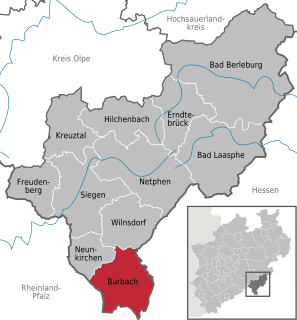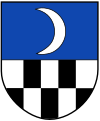Siegen-Wittgenstein is a Kreis (district) in the southeast of North Rhine-Westphalia, Germany. Neighboring districts are Olpe, Hochsauerlandkreis, Waldeck-Frankenberg, Marburg-Biedenkopf, Lahn-Dill, Westerwaldkreis, and Altenkirchen.

Wenden is a community in North Rhine-Westphalia, Germany. It belongs to the Olpe district in the Sauerland. It lies 10 kilometres south of Olpe and 20 km (12 mi) northwest of Siegen.

Dillenburg, officially Oranienstadt Dillenburg, is a town in Hesse's Gießen region in Germany. The town was formerly the seat of the old Dillkreis district, which is now part of the Lahn-Dill-Kreis.

Siegen is a city in Germany, in the south Westphalian part of North Rhine-Westphalia.

Olpe is a town situated in the foothills of the Ebbegebirge in North Rhine-Westphalia, roughly 60 km east of Cologne and 20 km northwest of Siegen. It is part of the Regierungsbezirk of Arnsberg and is the seat of the district of Olpe.

Kirchhundem is a German community in North Rhine-Westphalia. It belongs to the Olpe district.

Freudenberg is a town in the Siegen-Wittgenstein district, in North Rhine-Westphalia, Germany.

Hilchenbach is a town in the Siegen-Wittgenstein Kreis (district) of North Rhine-Westphalia, Germany.

Kreuztal is a town in the Siegen-Wittgenstein district, in North Rhine-Westphalia, Germany.

Netphen is a town in the Siegen-Wittgenstein district, in North Rhine-Westphalia, Germany. It lies on the river Sieg, roughly 7 km northeast of Siegen.

Rennerod is a town in the Westerwaldkreis in Rhineland-Palatinate, Germany. It is the administrative seat of the Verbandsgemeinde of Rennerod, a kind of collective municipality. Within the municipal area, until German Reunification on 3 October 1990, lay the Federal Republic's geographical centre.
Nassau-Siegen was a principality within the Holy Roman Empire that existed between 1303 and 1328, and again from 1606 to 1743. From 1626 to 1734, it was subdivided into Catholic and Protestant parts. Its capital was the city of Siegen, founded in 1224 and initially a condominium jointly owned by the archbishopric of Cologne and Nassau. It was located some 50 km east of Cologne, and it contained the modern localities of Freudenberg, Hilchenbach, Kreuztal, Siegen, and Wilnsdorf.

Meckenbach is an Ortsgemeinde – a municipality belonging to a Verbandsgemeinde, a kind of collective municipality – in the Bad Kreuznach district in Rhineland-Palatinate, Germany. It belongs to the Verbandsgemeinde Kirner Land, whose seat is in the town of Kirn.

Alterkülz is an Ortsgemeinde – a municipality belonging to a Verbandsgemeinde, a kind of collective municipality – in the Rhein-Hunsrück-Kreis (district) in Rhineland-Palatinate, Germany. It is also a tourism community (Fremdenverkehrsgemeinde).

Neuerkirch is an Ortsgemeinde – a municipality belonging to a Verbandsgemeinde, a kind of collective municipality – in the Rhein-Hunsrück-Kreis (district) in Rhineland-Palatinate, Germany. It belongs to the Verbandsgemeinde Simmern-Rheinböllen, whose seat is in Simmern.

Burbach is a municipality in the Siegen-Wittgenstein district, in North Rhine-Westphalia, Germany.
Wilgersdorf is a village in the district Siegen-Wittgenstein in North Rhine-Westphalia, Germany.
Apart from that, it is also the biggest part of the municipality Wilnsdorf.

Count John V of Nassau-Siegen, German: Johann V. Graf von Nassau-Siegen, official titles: Graf zu Nassau, Vianden und Diez, Herr zu Breda, was since 1475 Count of Nassau-Siegen and of half Diez. He descended from the Ottonian Line of the House of Nassau. For a short time he was Stadtholder of Guelders and Zutphen. During his reign, the Katzenelnbogische Erbfolgestreit with the Landgraves of Hesse began, which did not end until 41 years after his death.

The Protestant Church in Wilnsdorf, North Rhine-Westphalia, Germany, was completed in 1913. It has been the main church for merged parishes from 2010. The official name of the new parish is Evangelisch-Reformierte Kirchengemeinde Rödgen-Wilnsdorf, The parish is part of the Kirchenkreis Siegen in North Rhine Westphalia.

Siegerland-Höhenring(Siegerland mountain ridge circular route) is an approximately 142-kilometre-long (88-mile-long) hiking trail in Germany that circles most parts of Siegerland in the districts of Siegen-Wittgenstein and Altenkirchen.





























